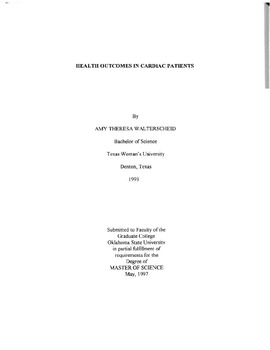| dc.description.abstract | Cardiovascular disease has accounted for 43% of all deaths since 1950, despite the declining mortality rate and the increase in technology and education (Cardiovascular Disease Statistics, 1996). Coronary heart disease is the leading cause of death for men over the age of 45 and for women over 65 years of age. Cardiovascular diseases account for $117 billion in health care costs and 736 years of potential years lost before the age of 65 (Burden of Chronic Disease & Infant Mortality, 1995). During 1993, the estimated number of hospital admissions for myocardial infarctions was 745,000 and for coronary artery bypass graph procedures was 485,000 (Monitoring Health Care in America, 1996). The estimated health care cost for coronary artery disease in 1994 was $56 billion and the loss of productivity was responsible for 14% of this cost (Cardiovascular Disease Statistics, 1996). Since the mid 1970's cardiac rehabilitation programs have been implemented to help patients understand and cope with heart disease while enabling them to return to their normal lifestyle through physical activity. However, even today, physical treatment and/or therapy for those who have undergone coronary artery bypass graph surgeries or have had a myocardial infarction often ends when the patient is discharged from the hospital. Cardiac rehabilitation programs serve as a link to bridge the gap between hospital discharge and resumption of daily activities. The content of cardiac rehabilitation programs vary, but most include exercise training, educational counseling and risk factor modification with the purpose of improving functional capacity, relieving symptoms and enhancing quality of life (Thompson, 1995). Benefits of cardiac rehabilitation typically include: increased exercise tolerance, improvement in cardiac symptoms, improved blood lipid levels, decreased smoking, improved psychological well-being and reduced mortality (Guidelines for Cardiac Rehabilitation, 1995). Unfortunately, less than a third of heart patients who are candidates for cardiac rehabilitation take advantage of the potential benefits that a cardiac rehabilitation program has to offer (Cardiac Rehabilitation - Beneficial but Under-Used, 1995). To identify the true benefits of the cardiac rehabilitation programs, as with many other treatments, outcome studies are useful and appropriate. Medical outcomes may include clinical end-points such as laboratory results, signs and symptoms, satisfaction of care ratings such as the quality of care, or well-being and/or functional status measures such as physical activity, mental health and limitations (Tarlov, et al., 1989). Selfreported measures from the patients are becoming increasingly important in measuring patient outcomes (McCarthy, et al., 1995). Often the physiological measurements do not correlate with the functional capacity and well-being of the patients. By using and identifying self-reported well-being and physical functioning patient outcomes, the results can be useful and provide meaningful results for both the clinicians and the patients (Guyatt, et aI., 1993). However, there is little evidence to date of cardiac rehabilitation studies that utilize comprehensive self-reported outcomes of well-being, physical functioning, social limitations, etc. Therefore, little documented information is available to determine how cardiac rehabilitation treatment impacts health-related patient outcomes. In response to the changes in the health care system, outcome studies have been conducted and have become an important part of health care research (Ware and Sherbourne, 1992). The Medical Outcomes Study was one type of research project conducted with two main purposes which were: 1) To relate varying patient outcomes with differences in patient care, clinician specialty training, intensity of resources used, and clinical styles 2) To develop more practical instruments to use in monitoring patient outcomes (Tarlov, et al., 1989). | |
